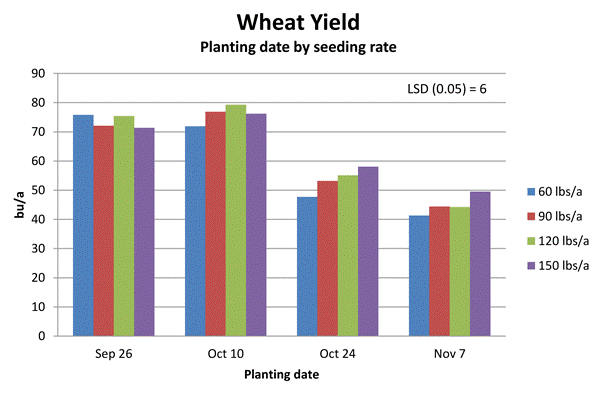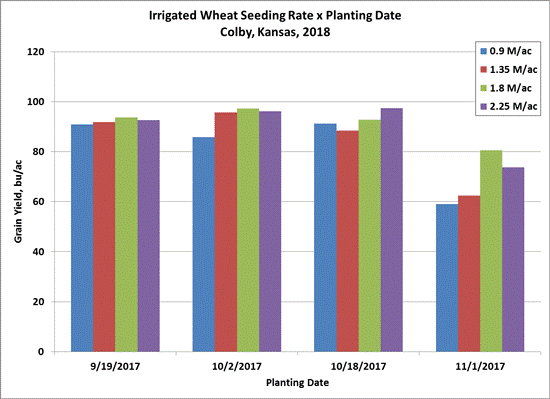The optimal planting window for wheat has passed for many areas of the state, such as northwest Kansas, with the end of the optimal window approaching in other areas. What is the effect on yield potential? Can increased seeding rates compensate if wheat planting is delayed beyond the optimal window?
It is important to recall that we rely heavily on fall-initiated tillers to contribute to grain yield. Fall tillers are generally more productive than spring tillers and are less prone to abandonment by the plant in the spring if stress conditions occur. Fall tiller initiation is driven by resource availability (water and fertility) and temperature. As planting is moved later into the fall, the window of opportunity for initiating fall tillers becomes much smaller. In the event of reduced fall tillering, the question becomes: Could increased seeding rates maintain yield potential?
To answer these questions, a four-year study was initiated in 2009 at the Northwest Research-Extension Center in Colby and completed in 2012. The results in 2011 were not used due to the dry spring conditions that reduced yields across all treatments. TAM 111 was seeded at four rates (60, 90, 120, and 150 lbs/acre) and at the four planting dates of September 26, October 9, October 28, and November 7. The actual planting date for a particular year was within three days of these planned planting dates. For the Colby area, September 26 would be considered an optimal planting date in most years, and October 10 would be the latter end of the optimal timeframe. October 28 is late for this area, while November 7 is very late. Figure 1 shows the four-year average yields for each treatment in the study.

Figure 1. Average 4-year dryland wheat yields for a study conducted in northwest Kansas evaluating planting date and seeding rates.
The following conclusions can be made from this study:
- Wheat yields were much higher when planted at the optimal time: Sept. 26 or Oct. 10.
- The studied range in seeding rates did not affect grain yield at the earliest planting date. This is because the plants have plenty of time to tiller, especially at the lower seeding rates.
- At the Oct. 10 planting date, the seeding rate did impact yield, with the 120 lbs/acre seeding rate yielding more than the 60 lbs/acre rate.
- When planting dates were later than optimal, increasing the seeding rate improved yields significantly. However, the higher seeding rates did not fully compensate for the effect of delayed planting. Even with an increased seeding rate, the combined effect of reduced tillering and lack of time for crown development resulted in lower yield potential.
- Increasing the seeding rate at late planting dates has the potential to compensate for the decreased tillering potential of wheat planted late, and increases yields compared to the lower seeding rates – although no amount of seed at a late planting date can overcome the overall effects of late planting.
In addition to the dryland study, beginning with the 2017-2018 wheat crop, seeding rate x planting date studies for irrigated wheat were started at Colby (Figure 2). Seeding rates ranged from 900,000 seeds per acre to 2.25 million seeds per acre while planting dates ranged from September 19 to November 1. While only one site-year of data has been collected, it is worth noting that the apparent response to seeding rate with delayed planting appears to be similar for irrigated wheat as was observed in the dryland study.

Figure 2. Irrigated wheat yields from 2017 for a study conducted in northwest Kansas evaluating planting dates and seeding rates.
Lucas Haag, Northwest Area Agronomist, Northwest Research-Extension Center
lhaag@ksu.edu
Brian Olson, Head of Western Kansas Research and Extension Centers, former Northwest Area Agronomist
bolson@ksu.edu
Romulo Lollato, Extension Wheat Specialist
lollato@ksu.edu